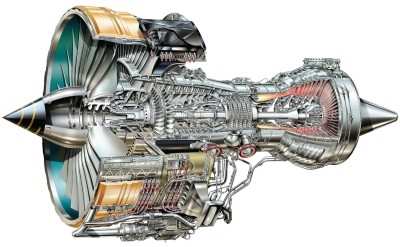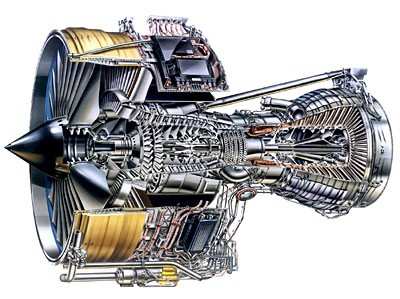AD 2021-18-05 Requires Initial And Repetitive Ultrasonic Or Visual Inspections
The FAA is superseding Airworthiness Directive (AD) 2020-15-12 for certain Rolls-Royce Deutschland Ltd & Co KG (RRD) Trent 1000 model turbofan engines.

AD 2020-15-12 required initial and repetitive ultrasonic or visual inspections of the intermediate-pressure compressor (IPC) stage 1 rotor blade root (front face), IPC stage 2 rotor blade root (front and rear face), and IPC shaft stage 2 dovetail post (front face), and removal of any cracked parts from service. AD 2020-15-12 also required an inspection after asymmetric power and cabin depressurization events. This AD was prompted by IPC rotor blade separations resulting in engine failures. This AD requires initial and repetitive ultrasonic or visual inspections of certain IPC stage 1 rotor blade root, IPC stage 2 rotor blade root, and IPC shaft stage 2 dovetail posts until replacement of the IPC stage 1 and stage 2 rotor blades with redesigned IPC stage 1 and stage 2 rotor blades in kitted sets. The FAA is issuing this AD to address the unsafe condition on these products. This AD is effective October 21, 2021.
Supplementary Information: The FAA issued a notice of proposed rulemaking (NPRM) to amend 14 CFR part 39 to supersede AD 2020-15-12, Amendment 39-21175 (85 FR 45081, July 27, 2020), (AD 2020-15-12). AD 2020-15-12 applied to certain RRD Trent 1000-A2, Trent 1000-AE2, Trent 1000-C2, Trent 1000-CE2, Trent 1000-D2, Trent 1000-E2, Trent 1000-G2, Trent 1000-H2, Trent 1000-J2, Trent 1000-K2, and Trent 1000-L2 model turbofan engines. The NPRM published in the Federal Register on April 22, 2021 (86 FR 21233). The NPRM was prompted by IPC rotor blade separations resulting in engine failures. Subsequently, the manufacturer identified the need to add new inspections and an optional terminating action, amend the asymmetric power condition for engine inspection, and to add an inspection after a cabin depressurization event. In the NPRM, the FAA proposed to continue to require initial and repetitive ultrasonic or visual inspection of the IPC stage 1 rotor blade root (front face), IPC stage 2 rotor blade root (front
and rear face), and IPC shaft stage 2 dovetail post (front face), removal of any cracked parts from service, and an inspection after asymmetric power and cabin depressurization events until the installation of the IPC stage 1 and stage 2 rotor blades with the IPC stage 1 and stage 2 rotor blades in kitted sets. The FAA is issuing this AD to address the unsafe condition on these products.
The European Union Aviation Safety Agency (EASA), which is the Technical Agent for the Member States of the European Community, has issued EASA AD 2020-0240, dated November 5, 2020 (referred to after this as “the MCAI”), to address the unsafe condition on these products.
The MCAI states:
- Occurrences were reported on Rolls-Royce Trent 1000 ‘Pack C' engines, where some IPC Rotor 1 and Rotor 2 blades were found cracked.
- This condition, if not detected and corrected, could lead to in-flight blade release, possibly resulting in reduced control of the aeroplane.
-
To address this potential unsafe condition, Rolls-Royce initially issued Alert NMSB TRENT 1000 72-AJ814 and 72-AJ819 to provide inspection instructions for IPC Rotor 1 blades, and IPC Rotor 2 blades and IPC shaft Stage 2 dovetail posts, respectively. Rolls-Royce also issued NMSB TRENT 1000 72-J871 to provide rework instructions for the affected parts, and Alert NMSB TRENT 1000 72-AJ869 to inspect those post-rework parts. Consequently, EASA issued AD 2017-0248 to require repetitive inspections of the affected IPC Rotor blades and IPC shaft Stage 2 dovetail posts and, depending on findings, removal from service of the engine for corrective action.

After that [EASA] AD was issued, Rolls-Royce issued Alert NMSB TRENT 1000 72-AK058 to provide instructions for a one-time on-wing inspection. Consequently, EASA issued AD 2018-0073, retaining the requirements of EASA AD 2017-0248, which was superseded, to require an additional borescope inspection of certain engines and, depending on findings, removal from service of the engine for corrective action.
After that [EASA] AD was issued, it was determined that repetitive borescope inspections are necessary on all engines to ensure fleet-wide continued safe operation. Consequently, Rolls-Royce revised Alert NMSB TRENT 1000 72-AJ869, Alert NMSB TRENT 1000 72-AJ814, Alert NMSB TRENT 1000 72-AJ819 and NMSB TRENT 1000 72-J871, and issued NMSB TRENT 1000 72-AK060 to consolidate all inspection instructions. Consequently, EASA issued AD 2018-0084 (later revised), retaining the requirements of EASA AD 2018-0073, which was superseded, and requiring repetitive on-wing borescope inspections of the affected Rotor 1 parts and affected Rotor 2 parts and, depending on findings, removal from service of the engine for corrective action. That [EASA] AD also introduced specific requirements for engines installed on aeroplanes involved in ETOPS, and inspection following operation in asymmetric power conditions.
Rolls-Royce then introduced NMSB Trent 1000 72-AK092 to provide inspections for the rear face of the Rotor 2 blades and NMSB TRENT 1000 72-AK060 was revised (R1) accordingly. Later, Rolls-Royce developed mod 72-J941, installing improved IPC Stage 1 and Stage 2 rotor blades, and issued the modification SB, providing the necessary instructions for in-service application. EASA issued AD 2018-0084R2 to exclude post-mod 72-J941 engines from the Applicability and introducing the modification SB as terminating action for the repetitive inspections as required by that [EASA] AD.
After that [EASA] AD was issued, Rolls-Royce issued NMSB TRENT 1000 72-AK313 and revised Alert NMSB TRENT 1000 72-AJ814, 72-AJ819 and 72-AK092 to introduce new inspections, new thresholds and new intervals, depending on engine configuration. These inspections are for all operations, ETOPS and non-ETOPS. The latest revision of the NMSB also amended the asymmetric power conditions for engine inspection and introduced cabin depressurisation as an event to trigger engine inspection(s).
- Consequently, EASA issued AD 2019-0250 to require introduction of the new inspections, replacing those previously imposed by EASA AD 2018-0084R2 (through NMSB TRENT 1000 72-AK060), and to remove the references to Engine Health Monitoring messages and ETOPS-related requirements.
Since that [EASA] AD was issued, it was discovered that the manufacturing distribution of the individual blade frequencies could differ from the assumed values during certification of the SB TRENT 1000 72-J941, which means there may not be sufficient margin to prevent the blades from experiencing high vibration levels. Prompted by these findings, Rolls-Royce issued the modification SB to provide blade kitting instructions.
You may obtain further information by examining the MCAI in the AD docket at https://www.regulations.gov by searching for and locating Docket No. FAA-2021-0306.
 ANN's Daily Aero-Term (05.09.24): Hold Procedure
ANN's Daily Aero-Term (05.09.24): Hold Procedure ANN's Daily Aero-Term (05.06.24): Altitude Readout
ANN's Daily Aero-Term (05.06.24): Altitude Readout ANN's Daily Aero-Linx (05.06.24)
ANN's Daily Aero-Linx (05.06.24) Airborne-NextGen 05.07.24: AI-Piloted F-16, AgEagle, 1st 2 WorldView Sats
Airborne-NextGen 05.07.24: AI-Piloted F-16, AgEagle, 1st 2 WorldView Sats Aero-News: Quote of the Day (05.07.24)
Aero-News: Quote of the Day (05.07.24)




